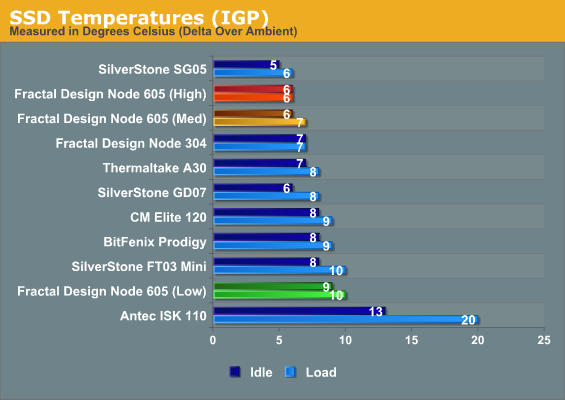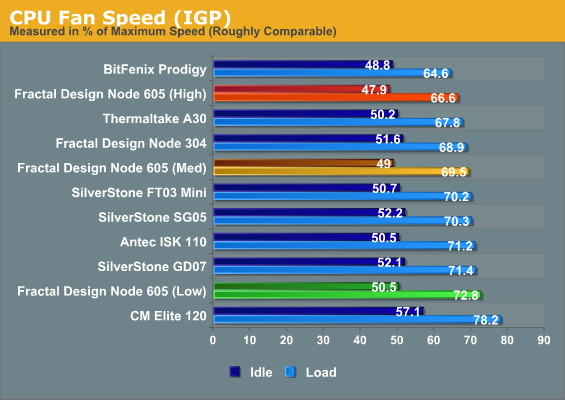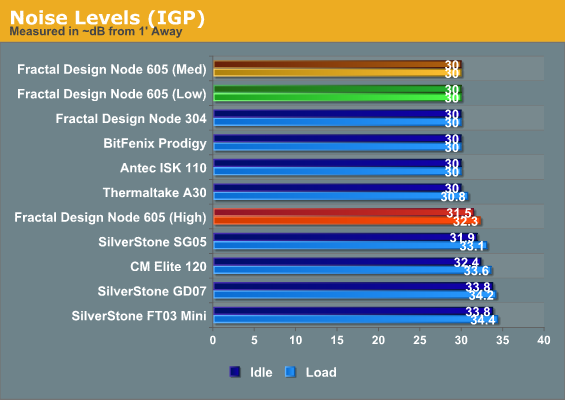Fractal Design Node 605 Case Review: Is Fractal Design Ready for Primetime?
by Dustin Sklavos on January 1, 2013 12:01 AM EST- Posted in
- Cases/Cooling/PSUs
- HTPC
- Fractal Design
Noise and Thermal Testing, IGP
The mITX testbed we use typically isn't particularly stressful; a case would have to be really dire to produce bad results here, and the Fractal Design Node 605 should handle this just fine. For basic home theater PC use, a CPU with equivalent or lesser wattage would be ideal along with a Micro-ATX board. We'll see what happens when dedicated graphics are added on the next page, but for now things should be pretty smooth.
The Node 605 was tested at each of its three fan settings with an ambient temperature of ~21C.


And here's where the bad news starts. The Node 605's thermal design is somewhat lacking. Fractal Design uses filters on all of its fans, but the problem is that the fans themselves aren't particularly powerful to begin with. If you bump up to the high setting you can get more mileage, but the case is definitely audible at that point as you'll see below.

Fan speed is capable of being competitive; Cooler Master's Elite 120 Advanced has a harder time keeping the CPU cool, but it's also half the size and a quarter of the price of the Node 605.

The Node 605's low and medium settings are competitive, but the high setting is too noisy for HTPC use.
With just the bare minimum hardware installed, the Node 605 is already struggling a little bit. CPU thermals are mediocre at best, but to get those thermals you have to ramp up the fans some, otherwise they're just bad. Perhaps more damningly, the smaller Node 304 actually produces better thermals and noise than the 605 does.










52 Comments
View All Comments
Blibbax - Tuesday, January 1, 2013 - link
If you for some reason insist on using only two fans, have one at the side (next to the PSU, I suppose) as an intake, and one next to the CPU above the backplate as an exhaust.Fractal have done what they have with the fans because they (rightly) assume that users will want to drop in at least one of their own choice of exhaust fan. Ignoring this in an otherwise excellent and well thought out review is a huge shame imo.
chrissp - Tuesday, January 1, 2013 - link
I havent seen any reviews for the Origin AE lineup on your site? I have the s14v in black and it is the nicest htpc case on the market imo. it is expensive but its made from a solid block of aluminium so i think its worth it.would love to see some reviews for their ranges on here.
thanks for the great great reviews.
chris
Conficio - Tuesday, January 1, 2013 - link
Really, what do you do with ports behind a flap? I might understand it for a card reader and may be a DVD drive? But head phones and mic and USB ports behind a flap? What is the user experience of this? If I use such things, the flap needs to stay open, so making the entire design horrid. I'd understand if the USB ports would be sideways and the flap had side channels to route the cables of an external drive, so I can still close it. But mic and head phone ports need to be outside of the flap!For that price, I'd like to see some display included, that can be controlled by software. I'd think that it must be possible to produce a simple display with a USB interface that can show output channel, and volume, etc. just by the virtue of it's driver. Not to mention adding any sort tuner card and being able to see tune information or similar.
kenyee - Tuesday, January 1, 2013 - link
with a 2500K, it's not even audible and there's enough space.Would have been nice if this case worked well though...having space for 4 drives would have been nice...
smitty123 - Tuesday, January 1, 2013 - link
i don't need flash , just something else than a gray slab.rockoqatsi - Wednesday, January 2, 2013 - link
I don't need flash either. And I'll deviate from most posters and say that this is one of the best HTPC chassis I've ever seen for the money (if only just from the front.)I like that the optical bay and all of the I/O ports are behind a flap. I don't need (visible) ports, a headphone or mic jack, and all sorts of buttons---and certainly not a volume knob---on my HTPC. I have a bloody preamp for that. And as far as VFDs and touchscreens go, they look pretty, but at the end of the day are a distraction. Touchscreens are for remotes anyway. An HTPC should be like Seraph from The Matrix: dark, svelte, mysterious, pretty, and silent.
So on the outside the Node 605 does just fine for me. It's such a shame the interior was designed by an ape. Why did they put the HDD hangers on the same side as the expansion slots, power supply and optical bay? The cpu side is like Montana and the other is like Tokyo. No f---ing sense for a case this size.
perrydoell - Wednesday, January 2, 2013 - link
After all these years, and no case designer cares to design their case with airflow in mind?I mean, all I see is a box with holes all around it. You design your own airflow, depending upon what you put in and where you put the fans. I'm sure a thermal engineer geek (I'm an electrical engineering geek myself :-P ) could design a case that has a single, well defined airflow path that could have far better thermal and accoustic performance than you or I could manage.
cjs150 - Thursday, January 3, 2013 - link
Silverstone TJ08-E springs to mind as clearly designed around proper airflow.Personally I wonder why there is a need for these big HTPC cases. To be honest they are nothing more than a standard 1990s case laid on its side. Having built a silent HTPC, mini-itx motherboard was sufficient for me (but I do have a separate NAS for storage), although I accept some audiophiles will want a separate audio card
Wwhat - Sunday, January 6, 2013 - link
It's amazing how involved people get with something that is just a metal box.And even more amazing and odd what some companies ask for it. Especially since some devices/tools/vehicles come with large metal housings and those don't seem to significantly influence the cost half the time.
But on the other hand some basically simple spare parts for cars that are very basic are also sold for outrageous prices if they are hard to source. It truly is a fine example of price and demand and making a business out of things.
dj christian - Thursday, January 10, 2013 - link
"ATX motherboard support on the right side of the case, power supply standing on its side on the left."should be
ATX motherboard support on the left side of the case, power supply standing on its side on the right.